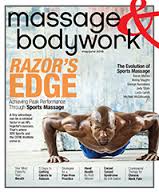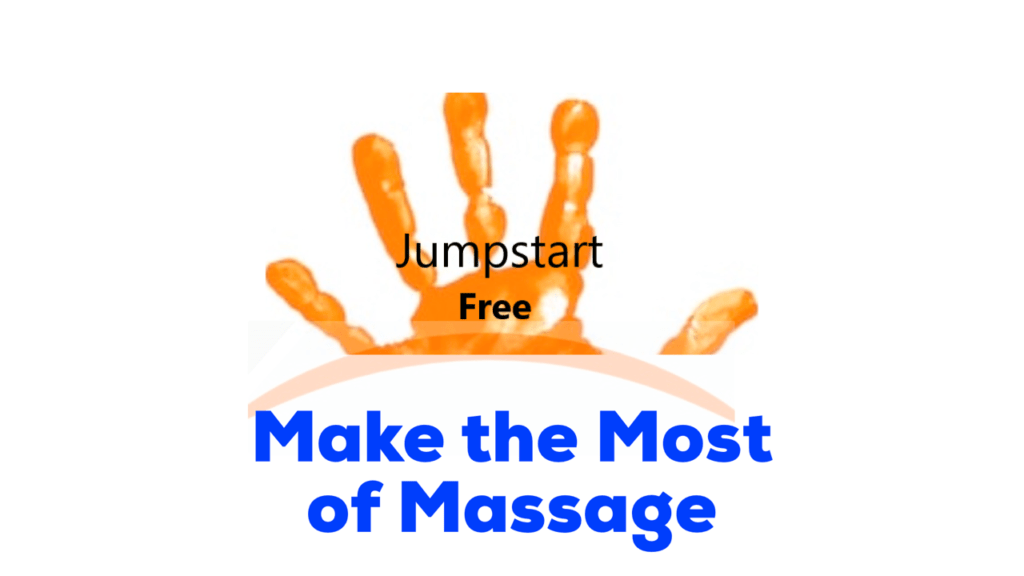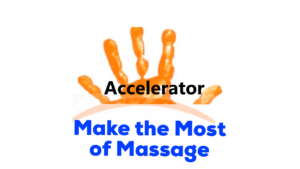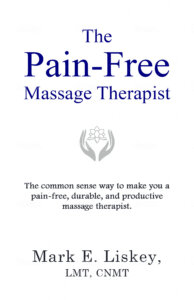Here are seven “injury prevention for massage therapy” strategies that keep me out of pain and allow me to increase my massage max.
- Stop doing techniques that hurt you.
- Find replacements for techniques that hurt you.
- Use as many body parts as possible.
- Use your body weight to apply pressure.
- Interrupt static postures.
- Use a massage tool.
- Become ambidextrous.
You may have laughed at the first strategy—stop doing the techniques that hurt you—but here’s the reality, it’s easier said than done.
1. Stop doing techniques that hurt you.
You learn a great scapula release technique at a CE class and your clients love it. Problem is, it hurts your hands. What do you do? Well, if you’re like me you keep doing it until it becomes a problem. I know I’m not the only one that does this.
Once I was training Susan, a massage therapist who was working for us.
She complained about that her right shoulder was really bothering her as the number of massages in a day increased.
So, we went into the massage lab to investigate. As she was working on me (tough experiment for me, haha) she said, Now…it hurts now.
Okay, what are you doing right now?, I asked.
When I got off the table she showed me what she was doing. Her right hand was under my back and she was doing a supine subscapularis release technique.
That’s it, she said, that’s exactly when my shoulder hurts.
I then asked her, Have you tried a different release technique?
She looked at me puzzled, and then said, I never thought about trying something different.
I showed her a side posture subscapularis release technique and it didn’t cause pain in her shoulder.
There was a flash of embarrassment on Susan’s face when she realized that she never thought about NOT doing the move that was hurting her shoulder.
I told her that we’ve all been there. In fact, you still might be there.
You might be thinking: This killer move is what my client wants, it’s my signature move, it’s the best move out there and/or I’ve done this move forever (in varying degrees of pain) so it’s my body that’s the problem, not the move.
Okay, let’s get rid of this “if I’m in pain doing massage, it’s okay” out of our heads right now because there’s a cumulative effect with this mindset. And it can set you up for more pain and potentially an injury.
No technique is worth an injury (or pain). If certain techniques bother your body, stop those techniques and…
2. Find replacements for techniques that hurt your body.
Here comes that voice again: “Nothing can replace my patented supine rhomboid move.”
I’m here to tell that voice, Yes, that move can be replaced.
And it can be replaced by a move that doesn’t hurt your body.
You just need to start experimenting.
For example, are you into squeezing traps?
If so, how do your hands and forearms feel after a 6 hour day of squeezing.
Mine didn’t feel so good. That’s why I started to experiment with different ways to release traps. In this video I use a massage tool to press instead of squeeze with my hands.
Now that you’ve agreed to stop doing the techniques that hurt your body and are starting to think about replacement techniques that don’t hurt your body, it’s time to…
3. Use as many body parts as possible.
When I say body parts I’m talking about fingers, thumbs, knuckles, fists, palms, forearms and elbows.
Why use as many body parts as possible?
So that you don’t burn out one body part.
Think about it—if you can alternate between fingers, thumbs, knuckles and elbows (in large muscles areas) for detail work, you can spread out the workload over multiple joints and body parts.
Spreading out the workload amongst body parts may look like this for detail work: 20% thumb, 20% fingers, 20% knuckles, 20% elbow, and 20% massage tool (we’ll talk about massage tools in a minute).
Hmm…100% using thumbs to do detail work versus 20% using thumbs…I’m going to say my thumbs will be a lot happier carrying only 20% of the workload for detail work.
We covered some injury prevention strategies for detail work and general massage, but what about for deep pressure massage?
4. Use your body weight to generate pressure.
When you use your body weight to generate pressure you take the strain out of your upper body. In fact, applying pressure pretty much becomes effortless. But in order use your body to the point that you can transfer your body weight onto the client, you’ll need to lower your table.
Twenty-five years ago I was taught that to set my table height, my distal knuckles should touch the top of the table when my arms were at my sides. Look on the Internet and you’ll find a range of table height advice, like: The height of your table should be your height divided by two.
Though well intended, there are some serious flaws with standardizing a table height setting that result in a loss of leaning leverage for medium and deep pressure. With no leverage, backs, hands, arms and necks get trashed because you need to overuse your upper-body when doing deep pressure.
But a lower than “normal” table is the set up to allow you to transfer all of your body weight (lean) onto the client.
If you don’t believe me try leaning onto your client at your normal table height. Then lower your table to the lowest setting, better yet, take off the extender legs so that the table is even lower than the lowest setting. Now lean.
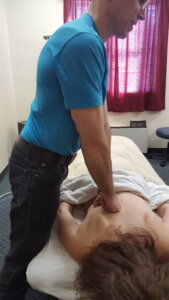
Do you see how you can now transfer all of your body weight onto your client if you wanted to?
It will take you some experimentation to figure out which lower table height setting works best for you when doing deep pressure. My suggestion is this: Whichever setting you’re thinking about lowering your table to, go one if not two settings lower than that.
To learn more about working on a low table so that you can lean effectively, go here.
Leveraging your body weight to deliver pressure is going to take the strain out of your upper-body, but we have something else to consider that can lead to fatigue and cause us pain and potentially contribute to injury—static posture. Here’s what we’re going to do:
5. Interrupt static posture.
First, what is static posture?
Static pressure is being in a position for a long time without moving. It often looks like this during a massage:
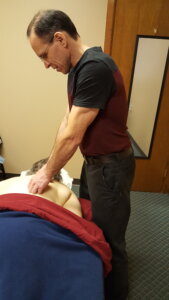
Static posture is bad because protracted static posture increases loads or forces on muscles and tendons in specific areas. When this happens fatigue occurs in these areas because blood flow is impeded. When blood flow is impeded there’s less replenishing of nutrients and elimination of metabolic waste. In other words, tissue recovery is not good.
Here’s an example of how you can disrupt static posture during a massage.
Look at the picture above. I’m hunching with my head down, a common static posture position.
So how I can I interrupt this static posture massage cycle without rewriting how I do massage?
One way is to find times during the massage when you can change your back position. Here are some examples:
1. Take a knee on the table when standing and working on feet.
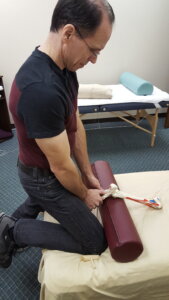
2. Sit and lean whenever possible.
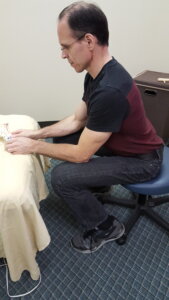
3. Massage with one hand so that you can straighten up.
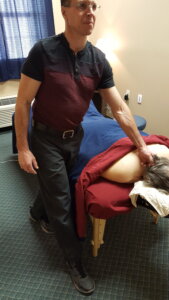
This article will give you a more in-depth understanding of how to break static posture during a massage: Don’t Do Static Posture Massage.
Breaking static posture will become the norm once you start experiencing the huge benefits of not being in the same position all the time.
Speaking of big rewards, I now want to show you how massage tools can save your hands.
6. Use massage tools.
I’m not talking about any massage tool. I’m specifically talking about massage tools that have a handle and a stem.
Why?
Because a handle makes the tool easy to hold, and a stem does a fantastic job of simulating a thumb.
Here what tools with handles look like:
Here’s a T-bar:
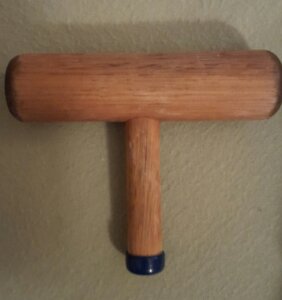
And here’s a long stem T-bar:

(Thank you Matt Johnson for designing and making my wooden tools!)
Massage tools with handles come in a lot of different flavors, but I really want to emphasize the importance of the handle.
The Importance of a Handle
The handle allows you to easily hold the massage tool BUT I’m not talking about holding a handle in the traditional sense–wrapping your hand around the handle and gripping.
I’m talking about using the handle to support your body weight. Think of parallel bars or push-up stands where you’re simply supporting your body weight on an apparatus.
Holding a Massage Tool
With a massage tool you are directing some of your body weight onto the handle of the tool.
If the massage tool is pinned between your hand and the tissue you’re working on, you can loosen your grip.
And if you add a guide finger/thumb next to the end of the stem of the massage tool, you can actually relax your “holding” hand.
Here’s what that looks like:
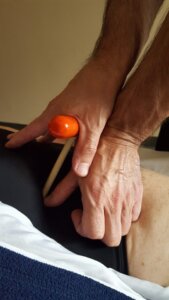
See how relaxed my hands are?
My guide fingers is helping to stabilize the tool. I’m also sensing how much pressure I am applying with my guide finger.
This all looks great, right? But when you actually go and try to hold a T-bar or L-bar without gripping you’re going to say–Mark, you’re a freakin’ liar–because it’s not going to work.
Why isn’t it going to work?
Because your table won’t be low enough. And that means you’re not going to be able to lean onto the massage tool handle with enough pressure to keep the tool upright without gripping.
Leaning into a massage tool, like leaning into the client with your hands, is not rocket science. It just takes practice.
The last injury prevention recommendation I have is to…
7. Become ambidextrous.
Raise your hand if you’re severely one-sided!
I was. It felt unnatural and inefficient to use my non-dominant side.
Why?
Because it WAS unnatural and inefficient to use my non-dominant side.
But with a little practice I got a little better and soon the idea of becoming competent with my non-dominant side didn’t seem that farfetched.
This isn’t exactly what I did, but I think it will get you to where you want to be. For the next 50 massages, every time you use a dominant-side body part for detailed work (e.g. right thumb), use a non-dominant-side body part (left thumb), too.
Make it easy when you first start by only placing a non-dominant-side body part down for 1 or 2 seconds. Gradually add more time.
As you add time, explore with the non-dominant-side body part.
Why not? We have the perfect work situation to explore.
Seriously.
For one, we can eye the client for reactions.
Get a squirmy reaction, then stop and try again in a different place or on a different client.
We also know what it feels like to get a massage. We know when pressing on a spot too long starts to feel uncomfortable.
And that on-the-table sense is always running as we’re doing the massage. To build that sense up, get more massages. I’m always amazed how much I learn when I’m actually the one getting the massage.
Injury Prevention for Massage Therapy in a Nutshell
If you’re feeling like injury prevention is a little daunting, step away from my specific recommendations for a minute and think in broader terms.
To prevent repetitive stress injuries you don’t want to keep racking up the massage hours with a particular body part, like your thumbs.
So what do you do?
You can become ambidextrous, use many body parts (and combination body parts) and massage tools.
To prevent injuries that are caused from overstraining, use your body weight to generate pressure, stop doing the techniques that hurt you and find replacement techniques.
To avoid injuries due to muscle fatigue from being in one position too long, find other positions to do your work.
It took me a while to get this about massage injuries: Avoiding injuries (and pain) when doing massage is an active process. It’s not an off and on thing. In fact, it always needs to be on. When it is, it becomes part of your massage style and what makes you unique and keeps you injury free.
Have a pain/injury issue?
Take my pain quiz and get an instant video solution.
PAIN QUIZFor more about staying injury and pain free, sign up for my email group. It’s free:-)


